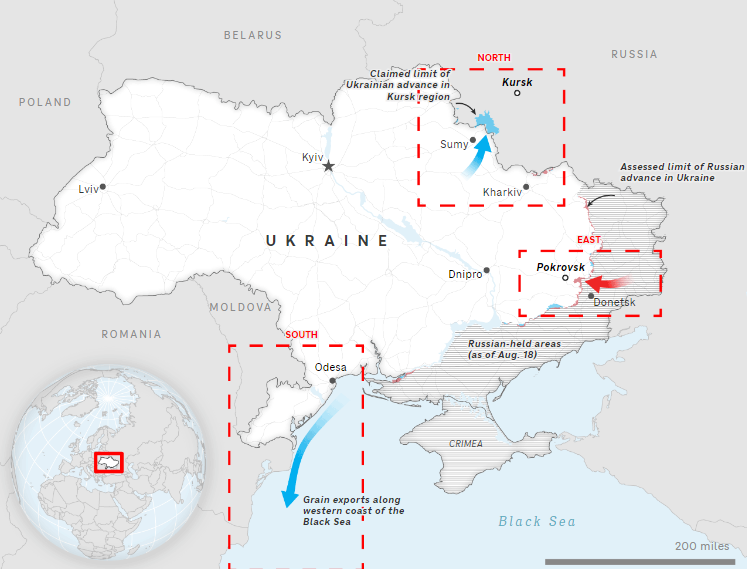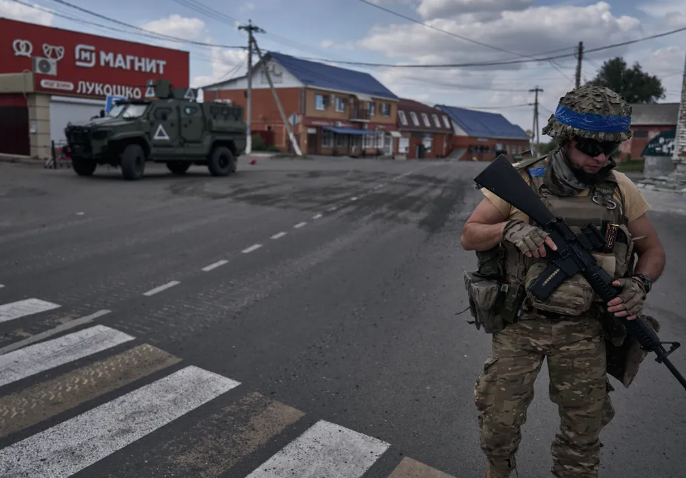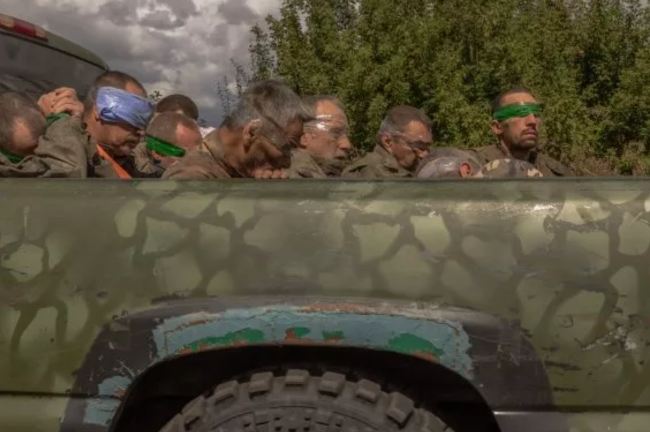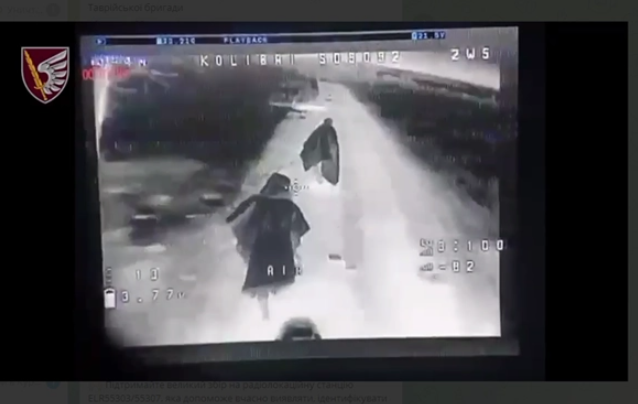The front line in the Russia-Ukraine conflict stretches more than 900km. But in reality it is centred on three separate fronts – in the north, east and south of Ukraine – all of which are playing out very differently.

The latest front lies just across the border in northern Ukraine, where Ukrainian troops made a surprise incursion into Russian territory on August 6 and are consolidating their positions two weeks after that breakthrough.
In eastern Ukraine, Russian forces have made steady advances and are closing in on a town vital to Ukraine's military supply lines.
And to the south, on the Black Sea, Ukraine has dealt a series of blows to the Russian navy and created a corridor that allows it to export wheat and other agricultural products.
The prospect of a “buffer zone” on the northern front
Earlier this week, Ukraine said it had blown up three bridges over the Seym River in western Russia, rendering them useless. The move cut off vital transport routes that Russia could use to send reinforcements into the Kursk region, with the aim of pushing back Ukrainian forces that have made some territorial gains in the past two weeks.
However, it also shows that Ukraine is on the defensive and is not seeking to advance further into Russia, at least in this region.

In a video address on the evening of August 19, Ukrainian President Volodymyr Zelenskyy said Ukraine was trying to keep Russia away from the border area from which Moscow had launched attacks against Ukraine. “The creation of a buffer zone on the territory of the aggressor is our activity in the Kursk region,” Mr. Zelensky said.
In May, the Russians attempted to enter the city of Kharkov, just over 30km from Ukraine. Ukraine held off a Russian ground offensive, although the city and surrounding areas were regularly hit by airstrikes with glide bombs that were difficult to defend.
After rapid advances in the first few days of the offensive, Ukrainian forces inside Russian territory have made only limited gains over the past week. Ukraine has yet to provide details of the operation, but military analysts and a series of media reports say Ukrainian forces are consolidating their positions.
The Ukrainian military says it has captured more than 80 villages and towns and now controls more than 600 square kilometers in the Kursk region, while also taking at least several hundred Russian prisoners. But those figures cannot be independently confirmed.
Meanwhile, Russia has yet to mount a significant counterattack. Russian officials say reinforcements are on the way, and Russian television has shown troops and equipment moving toward Kursk.

But so far the fighting appears to be limited to small-scale clashes. The Russians appear to be drawing forces from other parts of Russia — not from frontline troops fighting inside Ukraine, as Kiev has claimed.
Eastern front, Russian army is overwhelming
Eastern Ukraine remains the main front. The Russians claimed to have captured a small town on August 19 and are now just 15km from the strategic city of Pokrovsk.
Pokrovsk is a transport hub that Ukraine uses to move troops and supplies to frontline positions in the east. If the Russians take it, Ukraine will have a harder time supporting its already outnumbered and outgunned forces.
For days, Ukrainian officials have been urging civilians in Pokrovsk to evacuate to safer areas. “With each passing day, there is less time to collect personal belongings and leave for safer areas,” Pokrovsk officials said in a recent statement.
Throughout the war, Ukraine has been short of troops in the east. By sending thousands of troops into Russia, Ukraine could inflict even more damage on areas struggling to contain Russia’s advance.

According to President Zelensky, arms packages from the United States and European countries are arriving but not fast enough. “We need to speed up the deliveries from our partners,” Zelensky said in a speech on the evening of August 18. “War has no holidays. We need solutions, we need timely logistics for the announced [weapons] packages. I appeal in particular to the United States, Great Britain and France.”
Black Sea Front - Ukraine establishes export channel
One of Ukraine's biggest successes over the past year has been to push back the Russian navy in the Black Sea and establish a shipping channel so it can re-export grain and other agricultural products to world markets.
Russia dominates the Black Sea and has blocked Ukrainian exports after launching a “special military operation” in 2022. A deal brokered by the United Nations and Türkiye to allow Ukraine to export grain collapsed last summer.
But Kiev has found its own solution. Ukraine has fired missiles from land, attacking Russian ships that venture too close to its shores. It has also developed unmanned boats to launch suicide attacks on Russian ships.
Retired US Admiral James Foggo, who served with the Ukrainian Navy in the Black Sea a decade ago, said the unmanned boats showed the ingenuity of the Ukrainian navy.
“They’re jet skis with explosives in them,” said Mr. Foggo, who now heads the Center for Maritime Strategy in Arlington, Virginia. “They have some kind of remote control from some kind of command center. I don’t know what kind of radio control is on these things, but they’re pretty good.”
Ukrainian missile and drone attacks have forced Russian ships to withdraw from the western half of the Black Sea, opening up the waterway along the western coast to Ukrainian exports.
Ukraine announced last week that a year after the measure was introduced, 2,300 cargo ships had used the route, an average of more than six trips a day. Kiev also said it was approaching pre-war exports of wheat and other agricultural products at around 5 million tonnes a month.